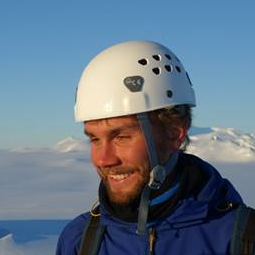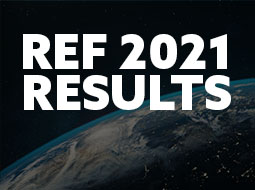-
Study
-
Quick Links
- Open Days & Events
- Real-World Learning
- Unlock Your Potential
- Tuition Fees, Funding & Scholarships
- Real World Learning
-
Undergraduate
- Application Guides
- UCAS Exhibitions
- Extended Degrees
- School & College Outreach
- Information for Parents
-
Postgraduate
- Application Guide
- Postgraduate Research Degrees
- Flexible Learning
- Change Direction
- Register your Interest
-
Student Life
- Students' Union
- The Hub - Student Blog
- Accommodation
- Northumbria Sport
- Support for Students
-
Learning Experience
- Real-World Learning
- Research-enriched learning
- Graduate Futures
- The Business Clinic
- Study Abroad
-
-
International
International
Northumbria’s global footprint touches every continent across the world, through our global partnerships across 17 institutions in 10 countries, to our 277,000 strong alumni community and 150 recruitment partners – we prepare our students for the challenges of tomorrow. Discover more about how to join Northumbria’s global family or our partnerships.
View our Global Footprint-
Quick Links
- Course Search
- Undergraduate Study
- Postgraduate Study
- Information for Parents
- London Campus
- Northumbria Pathway
- Cost of Living
- Sign up for Information
-
International Students
- Information for International Students
- Northumbria and your Country
- International Events
- Application Guide
- Entry Requirements and Education Country Agents
- Global Offices
- English Requirements
- English Language Centre
- International student support
- Cost of Living
-
International Fees and Funding
- International Undergraduate Fees
- International Undergraduate Funding
- International Masters Fees
- International Masters Funding
- International Postgraduate Research Fees
- International Postgraduate Research Funding
- Useful Financial Information
-
International Partners
- Agent and Representatives Network
- Global Partnerships
- Global Community
-
International Mobility
- Study Abroad
- Information for Incoming Exchange Students
-
-
Business
Business
The world is changing faster than ever before. The future is there to be won by organisations who find ways to turn today's possibilities into tomorrows competitive edge. In a connected world, collaboration can be the key to success.
More on our Business Services-
Business Quick Links
- Contact Us
- Business Events
- Research and Consultancy
- Education and Training
- Workforce Development Courses
- Join our mailing list
-
Education and Training
- Higher and Degree Apprenticeships
- Continuing Professional Development
- Apprenticeship Fees & Funding
- Apprenticeship FAQs
- How to Develop an Apprentice
- Apprenticeship Vacancies
- Enquire Now
-
Research and Consultancy
- Space
- Energy
- AI and Tech
- CHASE: Centre for Health and Social Equity
- NESST
-
-
Research
Research
Northumbria is a research-rich, business-focused, professional university with a global reputation for academic quality. We conduct ground-breaking research that is responsive to the science & technology, health & well being, economic and social and arts & cultural needs for the communities
Discover more about our Research-
Quick Links
- Research Peaks of Excellence
- Academic Departments
- Research Staff
- Postgraduate Research Studentships
- Research Events
-
Research at Northumbria
- Interdisciplinary Research Themes
- Research Impact
- REF
- Partners and Collaborators
-
Support for Researchers
- Research and Innovation Services Staff
- Researcher Development and Training
- Ethics, Integrity, and Trusted Research
- University Library
- Vice Chancellors Fellows
-
Research Degrees
- Postgraduate Research Overview
- Doctoral Training Partnerships and Centres
- Academic Departments
-
Research Culture
- Research Culture
- Research Culture Action Plan
- Concordats and Commitments
-
-
About Us
-
About Northumbria
- Our Strategy
- Our Staff
- Our Schools
- Place and Partnerships
- Leadership & Governance
- University Services
- Northumbria History
- Contact us
- Online Shop
-
-
Alumni
Alumni
Northumbria University is renowned for the calibre of its business-ready graduates. Our alumni network has over 253,000 graduates based in 178 countries worldwide in a range of sectors, our alumni are making a real impact on the world.
Our Alumni - Work For Us
Northumbria University is leading UK operations of PROPHET, part of the International Thwaites Glacier Collaboration (ITGC). This is a major interdisciplinary project seeking to answer important questions about one of the fastest changing areas of Antarctica.
This project is being undertaken in the Department of Geography and Environmental Sciences by members of the Cold and Palaeo Environments research group. The team at Northumbria is lead by Professor Hilmar Gudmundsson, the Principal Investigator of the UK side of PROPHET. The other team members are Jowan Barnes, Jan De Rydt, Sebastian Rosier and Camilla Schelpe.
PROJECT OVERVIEW
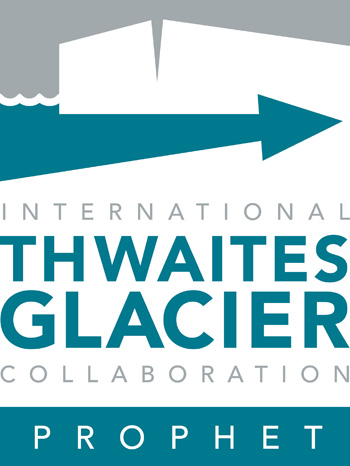 The ITGC is the largest collaboration between the UK and USA in Antarctica for 70 years. It has been granted £20 million in funding jointly by the UK Natural Environment Research Council (NERC) and the US National Science Foundation (NSF), and is taking place over a 5 year period.
The ITGC is the largest collaboration between the UK and USA in Antarctica for 70 years. It has been granted £20 million in funding jointly by the UK Natural Environment Research Council (NERC) and the US National Science Foundation (NSF), and is taking place over a 5 year period.
There are eight components of the ITGC, of which PROPHET is one of two modelling studies. There are also four observational studies focusing on key dynamical processes, and two looking at the historical context of the glacier and surrounding ocean. The data collected in these observational projects will feed into the modelling work of PROPHET.
The aim of PROPHET is to predict near-future changes to Thwaites Glacier using state-of-the-art ice and ocean modelling informed by accurate and extensive observational data. PROPHET aims to improve the representation of important processes of glacier dynamics within ice flow models, and use the improved models to forecast the future evolution of the glacier and its contribution to sea level rise.
The following video was created by ITGC as an overview of the collaboration:
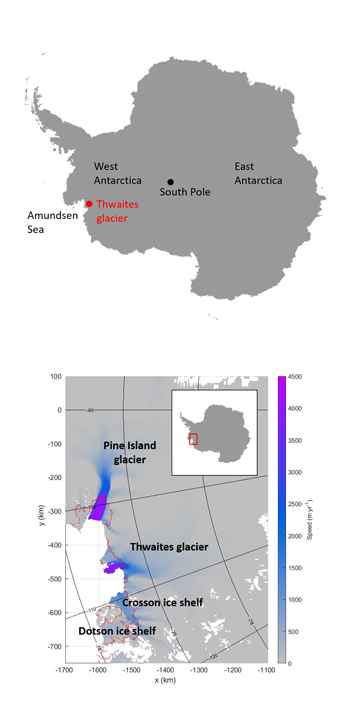 Thwaites Glacier is located in West Antarctica, in an area known as the Amundsen Sea Embayment (ASE) on the Antarctic coastline to the south of the Pacific Ocean. It is a very important region to study, and has gathered a lot of international interest over recent years.
Thwaites Glacier is located in West Antarctica, in an area known as the Amundsen Sea Embayment (ASE) on the Antarctic coastline to the south of the Pacific Ocean. It is a very important region to study, and has gathered a lot of international interest over recent years.
The glaciers in the ASE have been changing very quickly. Rising ocean temperatures and the resulting rapid ice loss means that Thwaites Glacier is under threat of entering unstable retreat, which would mean accelerated melting as more comparatively warm sea water fills the newly opening cavities under the ice. After entering unstable retreat, it would be unlikely to stop until the entire glacier has disappeared. Thwaites drains an area roughly the size of Britain, and lies on top of some of the deepest bedrock in Antarctica meaning that the ice can be very thick. If the entire glacier were to melt, it would raise global sea level by 65cm. There are fears that if this happens, it could destabilise more ice across West Antarctica.
Understanding the dynamics of Thwaites Glacier and its interactions with the atmosphere and ocean is therefore very important. We must attempt to work out how close it is to unstable retreat, and over what time scales the effects of its melting will contribute to the rising global sea level.
We have partners in the PROPHET project across other institutions in the UK and USA:
- Daniel Goldberg and Noel Gourmelen from Edinburgh University’s ‘Cryosphere’ research group
- Mathieu Morlighem from the ‘Ice Future’ research group at Dartmouth College
- Brent Minchew from the ‘Glacier dynamics and remote sensing’ group at Massachusetts Institute of Technology
- Indrani Das from Lamont-Doherty Earth Observatory
MODELLING: HOW WE PREDICT THE FUTURE
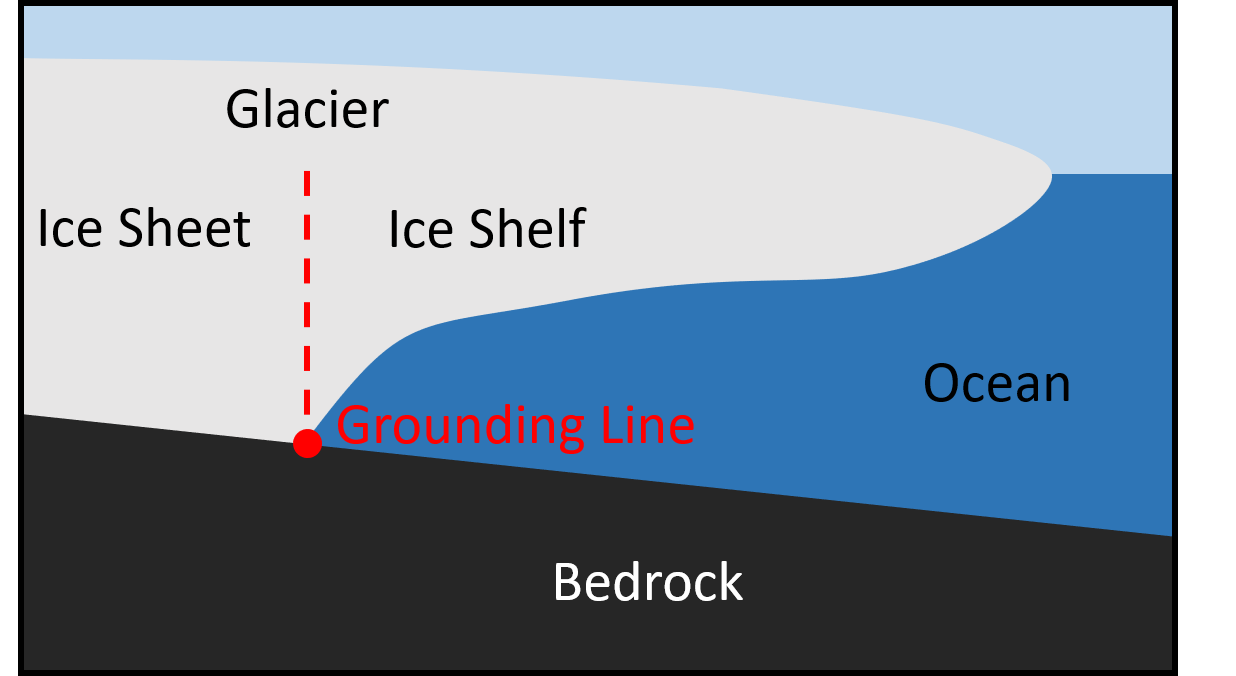 A glacier is a flowing body of ice. Glaciers in Antarctica, including Thwaites, flow out into the sea just as rivers do. The technical term for this is a marine-terminating glacier. Broadly speaking, the glacier can be split into two sections: the part which is in contact with the bedrock (ice sheet) and the part which floats on the ocean (ice shelf). The boundary between these sections is known as the grounding line. Different physical processes affect these two sections of the glacier, which makes the position of the grounding line a very important factor in the dynamics of the glacier.
A glacier is a flowing body of ice. Glaciers in Antarctica, including Thwaites, flow out into the sea just as rivers do. The technical term for this is a marine-terminating glacier. Broadly speaking, the glacier can be split into two sections: the part which is in contact with the bedrock (ice sheet) and the part which floats on the ocean (ice shelf). The boundary between these sections is known as the grounding line. Different physical processes affect these two sections of the glacier, which makes the position of the grounding line a very important factor in the dynamics of the glacier.
Mathematical models are used across many disciplines of science to investigate how systems change over time. Ice flow models can be used to predict how glaciers will behave in the future, or how they evolved in the past. We use powerful computers to perform the complex calculations required quickly and efficiently.
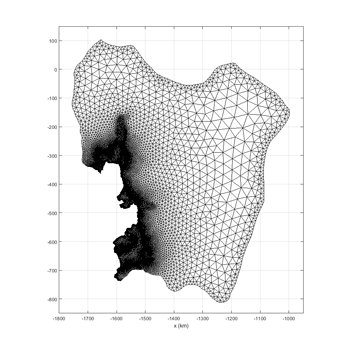 The model we use at Northumbria is called Úa. It calculates the ice velocities and thickness using a range of inputs we provide from both observational data and mathematical parameterisations representing physical processes. Before starting experiments, we set up a mesh which represents the area we are interested in. This mesh is made up of triangular elements, which gives us a lot of flexibility to control the size of elements in different parts of the domain. A calculation is performed for each mesh element, so the smaller the elements in an area the more detailed our results will be. The triangular structure also means the boundaries can be any shape we choose.
The model we use at Northumbria is called Úa. It calculates the ice velocities and thickness using a range of inputs we provide from both observational data and mathematical parameterisations representing physical processes. Before starting experiments, we set up a mesh which represents the area we are interested in. This mesh is made up of triangular elements, which gives us a lot of flexibility to control the size of elements in different parts of the domain. A calculation is performed for each mesh element, so the smaller the elements in an area the more detailed our results will be. The triangular structure also means the boundaries can be any shape we choose.
Once the domain is set up, we give the model information about the initial state of the ice and what is happening at the boundaries of our computational domain, then we run it forward in time. The model solves the system of equations which describe ice flow over a series of time steps, each time updating the relevant values before running the calculation again further into the future. We can instruct it to produce output for any particular time we are interested in.
An important part of the ice system is how it interacts with the ocean. Floating ice shelves at the ends of glaciers are the site of major factors influencing ice flow. The temperature of the ocean can cause ice to melt, or new ice to form from freezing seawater. Many simplistic parameterisations exist which allow ice flow models to account for this, but the best way to get an accurate idea of how ocean interactions affect the ice over time is to use coupled models.
Just as models are used to predict ice flow, there are also models used to simulate ocean circulation. We can use these to obtain values for the velocities, temperature and salinity of the water which comes into contact with ice shelves. Coupling ice and ocean models together can be a difficult process, and uses more computational time and resources than running an individual ice flow model. However, the results are generally more realistic.
At Northumbria, we couple the ice flow model Úa with the ocean circulation model MITgcm when performing coupled model runs.
Inverse modelling, or inversion, is an important part of initialising our model. This is an iterative process by which we derive values for properties of the ice flow which cannot be directly observed or measured. As an example, we use inversion to work out the basal friction coefficient, C, based on observed surface velocities.
The process begins with an initial guess at the C field. This can be anything from a single value applied across the entire ice sheet to a complex distribution based on previous knowledge of the area. This guess is then used as an input with which the model calculates the velocity field. After the calculation, the inversion algorithm finds the difference between the calculated velocities and the known measurements, known as the misfit. It will then adapt the initial guess for C with the aim of making the misfit smaller, and calculate velocities using its new version of C. This process repeats until the misfit is sufficiently reduced. The final C field, which provides a good match to observed velocities, can be used as a boundary condition when running the model forward in time to predict the future.
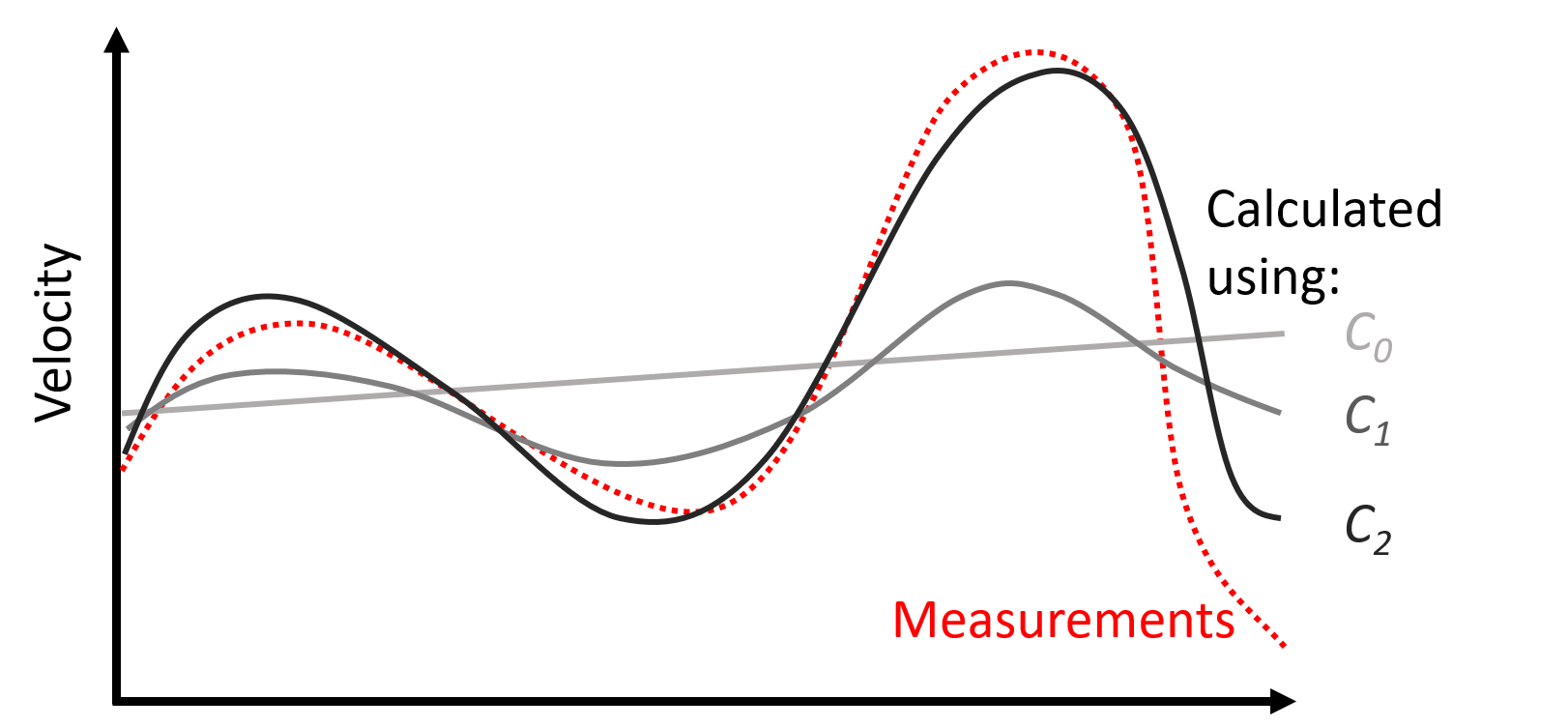 A simplified sketch of the results of this procedure is shown in the figure to the right, with C0 being the initial guess, and the adapted guesses C1 and C2 producing results which get closer to the measurements. It should be noted that while this illustrates the basic concept, the inversion processes used in models are more complicated than the curve fitting illustrated here.
A simplified sketch of the results of this procedure is shown in the figure to the right, with C0 being the initial guess, and the adapted guesses C1 and C2 producing results which get closer to the measurements. It should be noted that while this illustrates the basic concept, the inversion processes used in models are more complicated than the curve fitting illustrated here.
TOPICS UNDER INVESTIGATION
It is commonly thought that the results of inversions are unique to the model they are calculated in. This is because there are many complexities in ice flow modelling, and different choices are made in different models which can impact the outputs. There are dozens of different ice flow models used in our field of study, and it would be useful to know whether values calculated from inversion in one model are valid in others.
Across the PROPHET project, three models are being used. The modelling group here at Northumbria uses Úa, while our collaborators at other universities use models called STREAMICE and ISSM. All of these use inversion to calculate distributions of basal friction and the flow rate factor which represents internal ice properties in the equations. We are investigating the differences between the inversion processes, and whether the values calculated can be transferred between models for forward runs. This will depend on the extent to which the inversion outputs represent the underlying physics in the model equations, and how much they are affected by the individual numerical behaviour of the models.
Additionally, we are investigating the level of correlation between our inversion outputs and observations of reflectivity under ice derived from airborne radar measurements.
Among the equations which models use to calculate ice flow is the sliding law. This describes the relationship between velocity and basal stress, and contains the basal friction coefficient which is calculated by inversions.
There are several sliding laws which can be chosen, and the modelling community has not agreed upon which performs best. We are investigating the differences between model outputs, both inversions and forward runs, using different sliding laws. We hope to analyse the effects that each of these sliding laws has on ice flow, particularly how they each respond to changes in melt rates.
There are several processes from outside the ice sheet system which have an effect on Thwaites glacier, particularly where it meets the ocean. We call these external drivers of change.
We are running experiments to determine which of the external drivers have the greatest influence on the glacier. We are investigating the impacts of processes such as calving, ice shelf thinning rates and grounding line movement.
As described above, coupled modelling often produces the most realistic melt rates for an ice shelf. However, the process of coupling is far more computationally expensive and time-consuming. For many applications it is more useful to use a melt rate parameterisation, a simpler mathematical equation which can be directly included within an ice flow model.
As with many aspects of modelling, there are several options. We are using a parameterisation based on a plume model which calculates melt rates from information about the base of the ice shelf and depth profiles of ocean temperature and salinity. We are also investigating the potential of machine learning in predicting melt rates
Ice flow models rely on several input parameters which can introduce uncertainty into the outputs. We are working to quantify the uncertainty introduced by many of these parameters by using a surrogate model - a simplified version of the full model - to test thousands of combinations and see which produce results closest to those observed over the last few decades.
The results of this work will allow us to pick the best possible combinations of model inputs to improve our future predictions of how Thwaites will affect sea levels.
PROJECT OUTCOMES
With a wide range of undergraduate, postgraduate and distance learning Geography and Environmental Sciences courses, whatever you want to get out of university, let us show you why you want Northumbria University, Newcastle!
Our Geography and Environmental Sciences students learn from the best – inspirational academic staff with a genuine passion for their subject. Our courses are at the forefront of current knowledge and practice and are shaped by world-leading and internationally excellent research.
Looking to study in with us in September? Our Undergraduate Open Day Events are the perfect opportunity for you to find out as much as you can about our wide range of courses and world-class facilities.
Latest News and Features

Northumbria University leads pioneering research to tackle hidden lead exposure in children
Pioneering research launches in Leeds to test new approach to assessing the risk to children…

International students at Northumbria embark on FA Cup dream
A team of international college students studying at Northumbria University could soon find…

Northumbria expands results day support for students
Northumbria University is expanding and enhancing the support it provides to students receiving…
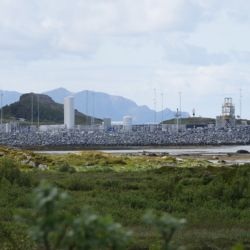
Supporting the ethical development of UK spaceports
A Northumbria University academic is helping to ensure the UK’s ambitions to build a thriving…
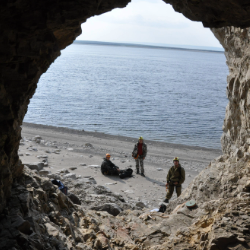
Research reveals Arctic region was permafrost-free when global temperatures were 4.5˚C higher than today
Scientists have found evidence that the Asian continent was free of permafrost all the way…

Northumbria wins recognition for expanding access to higher education
Northumbria University has been named Higher Education Institution of the Year at a prestigious…
Upcoming events

Viruses of Microbes-UK (VoM-UK) Conference 2026
Northumbria University

Commercialising SHAPE Innovations and Impact
Northumbria University
-




